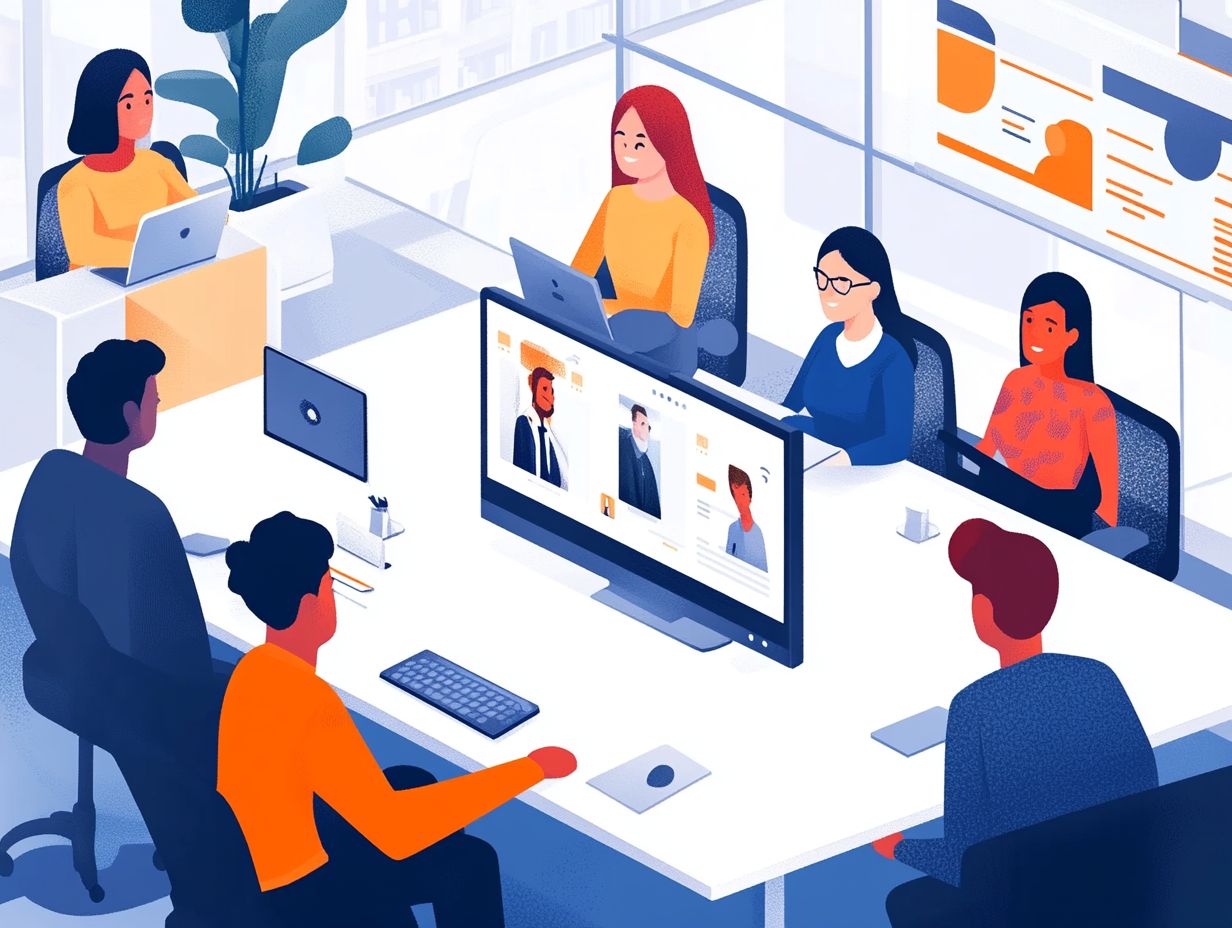How E-Learning Enhances Employee Engagement
In today’s fast-paced work environment, e-learning has emerged as a transformative tool for enhancing employee engagement.
This article delves into the various facets of e-learning, highlighting its flexible and convenient nature, as well as the personalized experiences it can offer.
You will discover how organizations can implement e-learning for effective training and continuous development while also examining key metrics that help measure its impact.
Uncover best practices to maximize engagement and foster a culture of learning within your workplace.
Dive in to explore how e-learning can revolutionize your team s growth and satisfaction!
Contents
- Key Takeaways:
- The Rise of E-Learning in the Workplace
- Benefits of E-Learning for Employee Engagement
- Implementing E-Learning in the Workplace
- Measuring the Impact of E-Learning on Employee Engagement
- Best Practices for Maximizing Employee Engagement with E-Learning
- Frequently Asked Questions
- What is e-learning and how does it enhance employee engagement?
- How can e-learning improve employee engagement in the workplace?
- What are the benefits of using e-learning for employee engagement?
- How can organizations ensure that their e-learning programs are effectively enhancing employee engagement?
- Are there any challenges to implementing e-learning for employee engagement?
- Can e-learning be used to enhance employee engagement for remote workers?
Key Takeaways:

- E-Learning offers flexibility and convenience, allowing employees to learn at their own pace and on their own schedule.
- Personalized learning experiences through e-learning can lead to higher levels of engagement and motivation among employees.
- Incorporating gamification, rewards, and regularly updating content can maximize the impact of e-learning on employee engagement.
The Rise of E-Learning in the Workplace
The rise of e-Learning in the workplace is revolutionizing how organizations tackle employee motivation and engagement. This shift creates a dynamic environment where HR professionals can cultivate a workforce that is not only engaged but also committed to personal growth and productivity, highlighting the impact of skill enhancement on employee engagement.
Companies like Salesforce and Starbucks have recognized the profound benefits of e-learning, leveraging it to boost employee retention and satisfaction. By incorporating modern training development methods, such as interactive e-learning and mobile learning, they are setting a new standard in employee development that others aspire to follow.
Overview of E-Learning
E-Learning represents a sophisticated array of online training methods that utilize a platform that organizes and delivers online training to deliver educational content with remarkable efficiency, ultimately reducing training costs and enhancing knowledge retention.
This modern method lets you use fun and interactive training materials, which can range from videos to quizzes and even simulation exercises. As a highly adaptable solution, it fits perfectly into every learning style, ensuring you fully grasp the concepts at hand.
The latest advancements in digital technologies, such as mobile learning applications and virtual classrooms, grant you the freedom to access resources anytime and anywhere, creating a more flexible and accommodating learning environment.
By incorporating feedback mechanisms and analytics, you can monitor progress and refine training outcomes, leading to a more skilled workforce that is well-equipped to navigate the demands of an ever-evolving landscape.
Benefits of E-Learning for Employee Engagement
E-Learning presents a wealth of advantages for enhancing employee engagement. It fosters greater employee satisfaction by leveraging e-learning for employee performance through personalized learning experiences tailored to individual needs.
It also creates opportunities for career growth through team-based learning programs that align with the diverse requirements of your workforce.
Flexibility and Convenience
The flexibility and convenience of e-Learning enable you to access training materials anytime and anywhere, significantly enhancing your commitment to ongoing personal growth and professional development.
This adaptability fits seamlessly into your often hectic schedule. For instance, mobile learning platforms allow you to engage with engaging content during your commute or on break, fostering a culture of continuous improvement without the constraints of traditional classroom settings.
With resources available at your fingertips, you can quickly turn to your device when questions arise or skills need refining. This accessibility leaves you feeling more enabled and engaged in your professional journey, ultimately leading to a more motivated and productive workforce.
Personalized Learning Experience

A personalized learning experience in e-Learning allows you to tailor training programs specifically to meet the needs of individual employees. This significantly enhances employee retention and improves performance management practices.
By harnessing technology that adjusts to different learning needs and engaging e-Learning strategies, you can craft immersive environments that resonate with various learning styles. These customized approaches not only boost engagement but also empower employees to take charge of their own learning journeys.
Incorporating features like gamification, real-time feedback, and scenario-based challenges creates a more dynamic experience. This ensures that each employee feels supported and motivated. When woven into your employee engagement initiatives, personalized learning cultivates a culture of continuous improvement, fostering a workforce that is not just skilled but also dedicated to their ongoing development.
Interactive and Engaging Content
Interactive and engaging content in e-Learning, enhanced by gamification strategies, elevates both your engagement and your knowledge retention. This occurs through enjoyable and immersive learning experiences.
This method of learning is particularly important in today s fast-paced corporate landscape, where motivation can sometimes take a backseat. By incorporating elements such as points, badges, and leaderboards, organizations offer a competitive edge that inspires active participation and a pursuit of excellence.
Imagine a company implementing role-playing scenarios that mimic real-world situations, allowing you to apply theoretical knowledge in a practical context. Quizzes and challenges serve as immediate feedback mechanisms, motivating you to stay committed while enjoying your journey toward professional development.
Implementing E-Learning in the Workplace
Implementing e-Learning in the workplace is a strategic decision that you can leverage as an HR professional to supercharge training and onboarding processes. This approach enhances your organization s capabilities and fosters a culture of continuous learning and development at every level.
Training and Onboarding
Training and onboarding through e-Learning can significantly enhance employee retention by providing clear pathways for performance management right from the start.
This digital approach fosters a seamless transition for new hires and equips them with the essential skills and knowledge tailored specifically to their roles. By leveraging interactive modules, regular assessments, and feedback loops, you ensure that employees feel engaged and supported throughout their initial phases.
Best practices for effective e-Learning include incorporating personalized learning paths, utilizing multimedia resources, and creating opportunities for social learning. Together, these elements contribute to a more dynamic training experience.
This method cultivates a productive workplace culture where ongoing learning aligns with overall performance goals. This enhances employee satisfaction and secures their long-term commitment to your organization.
Continuous Learning and Development
Continuous learning and development are vital for cultivating employee satisfaction and personal growth. This allows you to harness your organization s learning management systems to their fullest potential.
By fostering a culture of ongoing education, you can enhance the skill sets of your workforce while creating an engaging environment that inspires individuals to achieve their professional aspirations. E-learning platforms are instrumental in this journey, providing flexible access to resources that enable you to learn at your own pace.
This tailored approach accommodates diverse learning styles and addresses the specific needs of each employee, instilling a sense of ownership in their development.
Ultimately, these initiatives contribute to job satisfaction and drive overall business success.
Start integrating e-Learning today to see immediate benefits!
Measuring the Impact of E-Learning on Employee Engagement

Measuring the impact of e-learning on employee engagement demands an organized method. You need to identify key metrics and implement effective feedback mechanisms that can inform and enhance talent development strategies in future training initiatives.
This thoughtful process allows you to gain valuable insights and optimize your strategies for maximum engagement and effectiveness.
Key Metrics to Track
Key metrics to track in your e-learning programs include employee engagement levels, training development costs, and how well learners remember information. Together, these metrics offer valuable insights into the effectiveness of the training you provide.
By assessing these metrics, you can pinpoint which aspects of your e-learning initiatives resonate with employees and which areas might need a little extra attention. Employee engagement levels serve as a clear indicator of how invested individuals are in their learning journey, reflecting the relevance of your content and the quality of interactions.
Training development costs are essential for effective budgeting and resource allocation, ensuring that your investments deliver a satisfactory return.
Meanwhile, knowledge retention rates reveal how well information is absorbed and retained, helping you fine-tune future content and methodologies. By leveraging these metrics, you can make informed decisions that enhance the learner experience and elevate overall organizational performance.
Best Practices for Maximizing Employee Engagement with E-Learning
To truly maximize employee engagement with e-learning, you should embrace best practices, such as training employees on new e-learning tools, that cultivate a thriving culture of learning within your organization.
Incorporating gamification strategies can enhance the experience, making training not just informative but enjoyable.
Regular content updates keep the material fresh and relevant, ensuring that your team remains engaged and motivated throughout their learning journey.
Creating a Culture of Learning
Building a culture of learning is the key to energizing your team and boosting motivation! This commitment not only enhances individual skills but also propels overall business performance by fostering an environment where continuous improvement and innovation flourish.
By implementing strategies such as regular training sessions, mentorship programs, and collaborative projects, you can encourage knowledge sharing and provide opportunities for your employees to expand their capabilities.
Aligning learning initiatives with your team s career goals can significantly enhance engagement, as employees feel valued and invested in their personal development. Ultimately, this approach cultivates a more skilled workforce and boosts job satisfaction and retention, creating a win-win scenario for both your employees and the organization.
Incorporating Gamification and Rewards
Integrating gamification strategies and rewards into your e-learning programs can elevate employee engagement by transforming learning into an interactive and enjoyable experience.
By adding elements like points, badges, and leaderboards, you can cultivate a sense of competition and achievement among your learners.
Imagine a major tech company that rolled out a gamified learning platform, allowing employees to earn rewards for completing training modules and participating in quizzes. This approach not only motivated staff but also resulted in higher completion rates and enhanced retention of knowledge.
These successful implementations demonstrate how gamification can redefine the learning experience, turning it from a mere task into a captivating journey that actively involves learners. This change leads to a noticeable boost in productivity and enthusiasm for continuous learning within your workforce.
Regularly Updating and Improving Content

Regularly updating and refining your content is crucial for maintaining employee satisfaction and fostering effective training development that supports knowledge retention.
In fast-paced industries where information evolves rapidly, keeping training materials fresh and relevant is paramount. By revisiting your e-Learning programs, you can seamlessly integrate new insights, tools, and technologies that align with employees everyday experiences.
Your ongoing commitment to improving content keeps employees engaged and excited about learning! This investment in employee growth boosts engagement, as learners discover the material to be more applicable and captivating.
Incorporating different types of media or interactive features can significantly enhance motivation. Soliciting feedback from your team provides invaluable insights on how to tailor content for even greater impact.
Frequently Asked Questions
What is e-learning and how does it enhance employee engagement?
E-learning refers to the use of electronic technologies to deliver educational or training material. It enhances employee engagement by providing accessible, interactive, and personalized learning experiences. To maximize its effectiveness, consider exploring how to promote e-learning within your company.
How can e-learning improve employee engagement in the workplace?
E-learning can improve employee engagement by offering flexible and convenient learning options. By using e-learning for employee retention strategies, it increases knowledge retention through interactive multimedia, promoting a continuous learning culture in the workplace.
What are the benefits of using e-learning for employee engagement?
Some benefits of using e-learning for employee engagement include cost-effectiveness, scalability, and the ability to track and measure learning progress and engagement levels, as explored in how e-learning enhances knowledge retention.
How can organizations ensure that their e-learning programs are effectively enhancing employee engagement?
Organizations can ensure the effectiveness of their e-learning programs by regularly gathering feedback from employees. Continuously updating and improving content will also encourage the use of e-learning as a valuable tool for professional development.
Are there any challenges to implementing e-learning for employee engagement?
Some challenges to implementing e-learning for employee engagement may include a lack of technical skills, resistance to change, and the need for consistent internet access and technical equipment. However, proper training and support can help overcome these challenges.
Can e-learning be used to enhance employee engagement for remote workers?
Yes, e-learning can be a valuable tool for engaging remote employees. It provides them with accessible and flexible learning options, fosters a sense of connection to the organization, and promotes continuous learning and development opportunities, especially when considering how social learning enhances e-learning.
Ready to enhance your employee engagement through e-learning? Contact us for more information!






